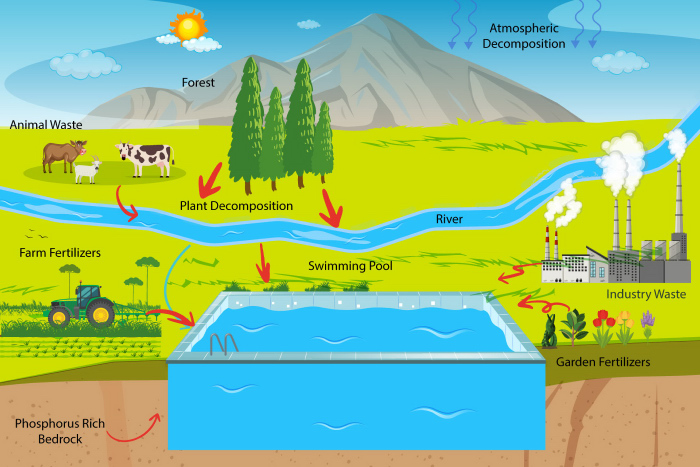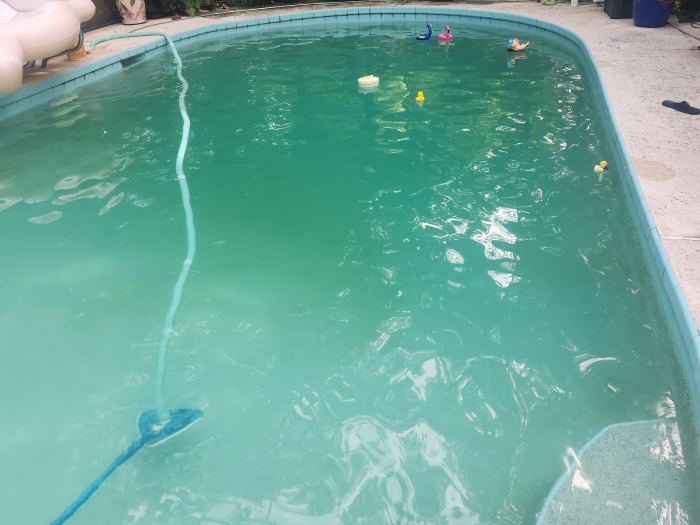When it comes to phosphates in pools, there’s a big debate going on among pool owners and pool professionals. Some will tell you to remove them, whereas others will say it’s not necessary. So what’s the right answer? Is it necessary to remove phosphates from your pool?
As a pool technician and someone who cleans many pools weekly, I have strong opinions on this topic. Here’s my take…
Phosphates are the main source of food for algae, and it is important to remove them from your pool if you have an ongoing algae problem or the phosphate level is above 500 PPB. Phosphates are easy to remove by adding a liquid phosphate reducer to your pool.
That’s the quick answer; now, let’s dig in a little.
Article Contents
What Are Phosphates in a Pool?
Phosphates are organic materials naturally occurring in your pool caused by dead leaves, fertilizer, paver stones, and other natural sources. It’s rare that they get to a level to be concerned about, but if they do, they should be treated immediately.
High levels of phosphates can cause explosive algae growth. Many pools will have a phosphate level of 100 PPB or less. But some pools will have higher levels. Where the problems can occur if phosphate levels are high.
How Do Phosphates Get into Pool Water?
Phosphates get into your pool by liquid runoff. Most often, this happens if paver stones surround the pool or a nearby area has been recently fertilized. This happens frequently on golf courses where the grounds are often fertilized, and the runoff then enters your pool or surrounding areas.
Check out the graphic we created below, to give you a better idea of how phosphates get into swimming pools.

Phosphates can come from sources that we cannot control, but they can also come from suntan lotions, washing detergents, fertilizers, and body oils.
How Do You Know You Have Phosphates?
Firstly, you can not see phosphates in your pool. However, you may see the indirect effects of phosphates. Such as:
- Inability to hold chlorine
- Chlorine usage greatly increased
- Algae & recurring algae
Phosphates show up in your pool in a number of ways, and the best way to know if you have phosphates is to have a reputable pool supply store test your water for minerals once a month or so. If the phosphate level is over 500 PPB, you need to add a phosphate reducer, or you risk the chance of a green pool, no matter if the other chemicals are balanced.
You also have another option of using a phosphate test kit. You could try this test kit here.
- Keep phosphates in check & prevent algae
- Quick & easy way to test & monitor phosphate levels
- Accurate results
Effects of Phosphates on Pool Water
High phosphate levels feed algae and promote extremely fast algae growth. If you’re concerned about phosphate levels in your pool, you must buy a specific test kit to test for them or have a pool store check for metals in a water sample.
High phosphate levels also use up your chlorine quicker, which also promotes even more algae growth. If you notice your chlorine level is depleting quicker than usual or you have recurring algae, have your phosphate minerals tested.
Is it Safe to Swim with High Phosphates?
Swimming in a pool with high phosphates is not dangerous or harmful directly. For instance, if you swim in a pool with high chlorine levels, you will probably detect this on your skin and in your eyes. It may irritate them.
However, you won’t feel any direct effects from swimming in a pool with high phosphates. This is why it is important to test for them no less than once per month. Once they get too high, you will have a green pool.
Do Phosphates Cause Algae to Grow?

Phosphates are algae’s number one food and cause algae growth in swimming pools. High levels of phosphates left untreated will cause an algae bloom. The higher the level of phosphates, the lower the amount of oxygen in the water. This is called eutrophication, and this leads to algae blooms.
Will Removing Phosphates Prevent Algae?
Keeping the phosphate level below 500 PPB will prevent algae growth and keep your pool chemicals balanced. Simply put, if there is no food source for algae, it cannot grow. Chlorine will kill or at least reduce algae growth but cutting off its food source means it cannot grow in the first place.
Are Phosphates Bad in a Pool?
Ideally, you don’t want any phosphates in your pool. However, this is rarely, if ever, possible. So long as you keep phosphate levels under control, your pool will remain healthy.
Please don’t think high levels of phosphates happen overnight. Phosphates take a while to accumulate to a level of concern. You should be fine if you test the minerals at a professional pool store once every few weeks.
Some pools will have more phosphates and increase faster than others. But after testing, you will get to know your pool. You’ll have a better idea of the rate phosphates increase over time. And once you know that, you can work out your own phosphate testing schedule.
Do Phosphates Affect Chlorine?
Phosphates in a swimming pool do not directly affect chlorine. There is an indirect effect, though. Excessive amounts of phosphates (above 500 PPB) can contribute to high levels of algae growth. And if you have a lot of algae or other contaminants in the pool’s water, this will use up and cause a low chlorine level in the water.
What are the Accepted Phosphate Levels?
The highest level that you want your phosphates to be is 500 PPB. But don’t think the pool is doomed as soon as it hits that number. For example, I recently visited my mother-in-law, who has a pool company performing weekly maintenance on her pool. The pool looked great, but I also know that most companies do not test for outstanding minerals (like phosphates) unless they are asked, or there is an obvious reason.
I took a water sample to a local pool supply store and had them run a full test. All the chemicals were perfect, except the phosphates were a whopping 2,000 PPB! I added a couple of ounces of phosphate remover, and the problem was solved. The point is that even if the phosphate level goes above 500 PPB, it doesn’t automatically turn the pool green.
When to Treat or Remove Phosphates From a Pool
There are two specific instances when you should treat or remove phosphates from your pool. That is when:
- Phosphates are above 500 PPB
- Your pool has recurring algae (but chlorine & stabilizer are fine)
1. Phosphates Are Above 500 PPB
The time to be concerned with phosphates and to remove them is if the level of phosphates reaches above 500 PPB. The solution is to buy a liquid bottle of phosphate reducer and add the prescribed ounces (there is a sight glass and measurements on the bottle). Test your minerals once a month on average or any time you have a bad runoff from a rainstorm or when there has been heavy fertilization near your pool.
A phosphate decreaser I’ve used in the past that works rather well is Natural Chemistry Phosfree.
- Maintains near zero phosphate levels
- Cleans waterline and filter
- Reduces surface oils and other non-living organics
2. Recurring Algae
You may also consider removing phosphates from your pool if you have algae that keep coming back. Sometimes algae will recur, particularly in stagnant areas of the pool, like near steps. If your pool maintenance is good, i.e., you keep it clean, filter 8-12 hours per day, and maintain the chemicals, and you still get algae, use some phosphate remover.
What about saltwater pools, should you remove phosphates?
If phosphate levels are above 500 PPB in a saltwater pool, you should remove them to be safe. When it comes to phosphates, the main reason to remove them is to help control algae. Saltwater pools are less prone to algae blooms, though, due to the continuous production of chlorine, so removing phosphates should only be necessary if the level exceeds 500 PPB.
What Do You Do to Remove or Control Phosphates?
There is no way to prevent phosphates from getting into your pool other than to test for them once a month. Phosphates are more likely to enter your pool after heavy rain. The water runoff carries phosphates.
Removing phosphates is simple; add a phosphate remover. If you have a lawn service or a heavily wooded area with bugs, you will get more phosphates as a natural course of nature.
Final Thoughts – Should You Remove Phosphates from Your Pool?
Phosphates are almost impossible to remove, but it’s nothing to worry about. The phosphate levels slowly rise; you will not see a difference overnight. If you periodically test your minerals, you can easily maintain the correct level of less than 500 PPB.
Phosphates in themselves are not harmful to you or your pool. But they can cause algae growth when they are high enough. That level differs with every pool and depends on your chemical balance, your filter, the pool maintenance, how clean your pool is, water temperature, and much more. There are too many factors to say.
If you have phosphates above 500 PPB or algae that keeps coming back, then you should lower the phosphate levels using a phosphate reducer.



